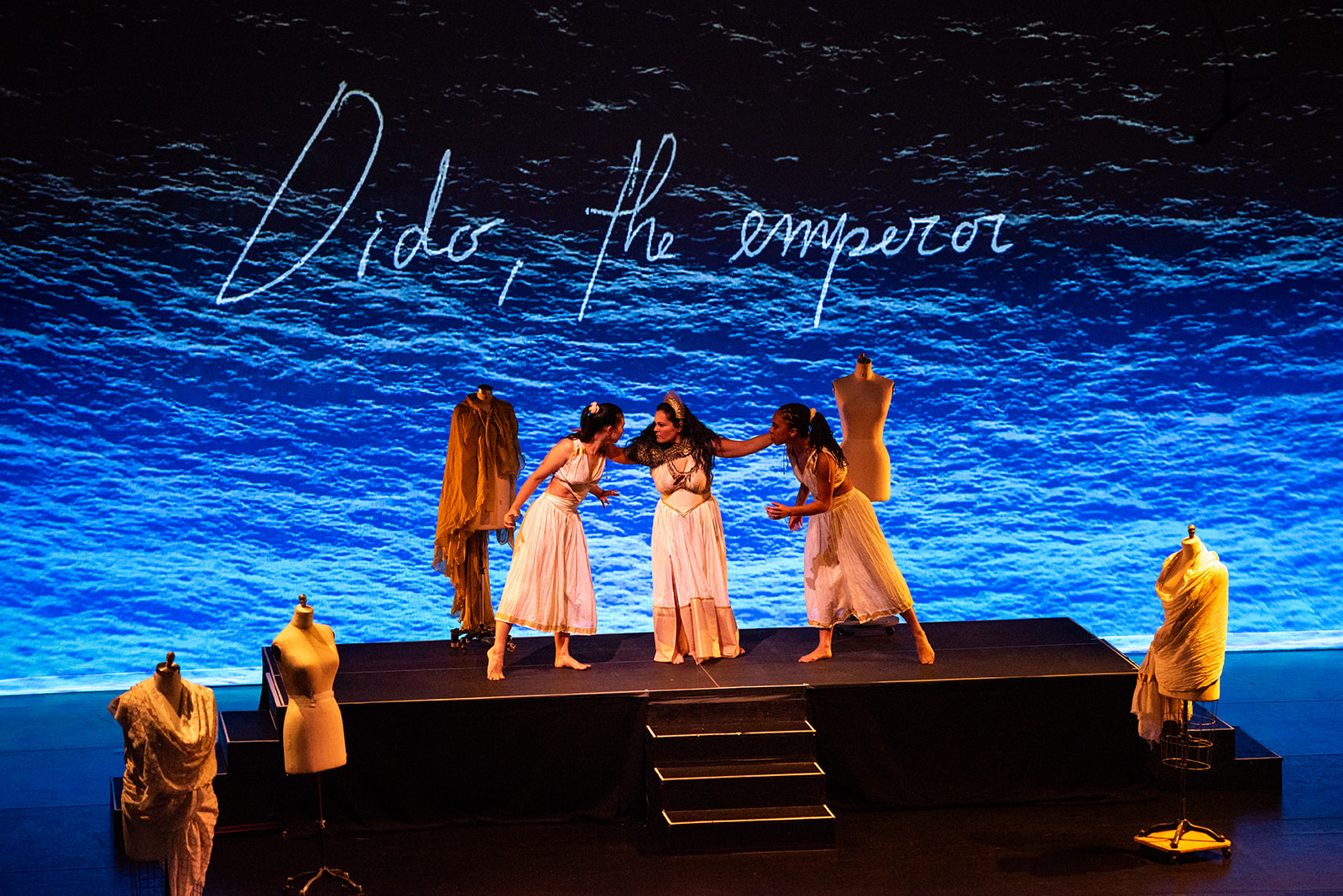The Queen of Carthage is a multi-media performance staged as part of the Early Music Vancouver 2023 Summer Festival. It was filmed in performance at Simon Fraser University and is now available on-line until January 5th. It’s a co-production of Early Music Vancouver and re:Naissance Opera, conceptualized and directed by Dr. Debi Wong.
The central concept is to explore the story of Dido, Queen of Carthage, beyond the well-known episode recounted in Book IV of Virgil’s Aeneid and turned into an opera by Nathum Tate and Henry Purcell. There is a single singer; mezzo soprano Cecilia Duarte, representing Dido, backed up by two dancers; Juolin Lee and Marisa Gold (also responsible for the choreography), and projections by Camilla Tassi. A nine instrument ensemble on period instruments is split into two groups at the sides of the stage. The music is a mixture of baroque (mostly 17th century) and works by contemporary female composers. The baroque composers include von Biber, Mudarra, the Eccles brothers and John Dowland, plus, of course, Purcell. We get extracts from Dido and Aeneas and just about all the semi-operas. Jessica McMann, Afarin Mansouri and Robyn Jacob contribute the contemporary element and all three pieces are worthy a listen
We are told in the director’s notes that one of the aims is to present a fuller picture of Dido as leader, seafarer and empire-builder which legend certainly portrays her as. And, one might add, a very typical Carthaginian who didn’t scruple at human sacrifice to achieve her political ends! The director goes on to claim: “At the same time, we emphasize the discord and struggles female-identifying and gender diverse people experience as they rise up in society”.
Despite the performance being split into six tableaux with titles like “Dido Our Ancestor” and “Dido the Emperor” this really didn’t come over. This may well be because the text on the new works and in the extra text added to “Come away fellow sailors” is extremely difficult to make out and there are no subtitles on the video. So, essentially we are left with a performance of a number of very loosely connected segments; often with no obvious connection with Dido.
The performance is good. Duarte sings well in both the baroque pieces and the contemporary works. The choreography is engaging and integrates Duarte nicely with the excellent dancers. The EMV Festival Players sound suitably baroque. The projections are sometimes abstract and at others more realistic with a giant Dido’s head for example. That said, their use is a bit inconsistent and they don’t seem to integrate with the action much of the time.
This lack of a sense of integration and continuity isn’t helped by the production for video. It’s a very hard show to film. The stage is very large for the small number of performers and it’s often quite dark. It’s extremely difficult to show the full picture, projections and all, that the director is presenting without reducing the figures on stage to insignificant shapes in semi-darkness. The alternative, of course, is close ups, but then the big picture is lost. I think this would have challenged the most experienced of video directors.
That said, the audio-visual quality is high and it’s presented via YouTube which allows for easy viewing on whatever viewing device one chooses. Registration is required to get the relevant url and a donation is requested.
I admire the conceptual ambition of this show and the desire to go beyond the idea of one of the great queens of the Ancient Mediterranean as something more than a love lorn suicide but it didn’t really come off for me. I suspect subtitles might have made a significant difference.
Related Content ↘
Opera Canada depends on the generous contributions of its supporters to bring readers outstanding, in-depth coverage of opera in Canada and beyond. Please consider subscribing or donating today.











